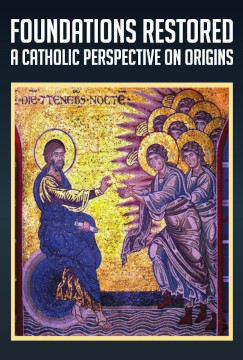- Welcome to St. Isidore forum.
Recent posts
#41
Catholic Resources / Re: Martyn Swain's complete au...
Last post by Wenura - November 25, 2023, 04:49:56 AMNo audiobook links
#42
Philosophy / Re: Prudence Question
Last post by tacf - November 24, 2023, 07:26:04 PMOk. I have since read the relevant section in Fr Chad Ripperger's book "Introduction to the Science of Mental Health". It seems everything can be categorized if you ask "where along the course of an act of prudence (going through subordinate acts counsel, judgement and command sequentially) does a particular part become necessary for a subordinate act to succeed?" Anyways, the categorization is following Q53A2 strictly, as that is where he lists all explicitly in categories, which I assume would mean that is where he is speaking most strictly about categorizations.
Anyways, here's a table using Fr. Ripperger as a counsel for understanding the relevant section of the Summa:

Anyways, here's a table using Fr. Ripperger as a counsel for understanding the relevant section of the Summa:
#43
Philosophy / Integral Parts of Prudence
Last post by Geremia - November 24, 2023, 10:51:42 AMIt's fascinating that memory in an integral part of prudence. Thomist psychologist Kevin Vost defends memorization in his Memorize the Reasons! Defending the Faith with the Catholic Art of Memory (memorize catechisms with Anki!) and Memorize the Latin Mass!: How to Remember and Treasure its Rites (using the "method of loci", places). The Medieval Craft of Memory and The Art of Memory mention St. Thomas's opuscule De memoria et reminiscentia.
Fr. Antonio Royo Marín, O.P., Theology of Christian Perfection p. 43 has a good diagram:

Ibid. pp. 372-3:
Fr. Antonio Royo Marín, O.P., Theology of Christian Perfection p. 43 has a good diagram:
Ibid. pp. 372-3:
Quote from: Royo Marín, O.P.Integral Parts of Prudence
Eight integral parts are required for the perfection of the virtue of prudence, five of which pertain to the intellectual aspect and three to the practical aspect. Each and every part will not necessarily function in every instance of the exercise of the virtue, but all must be possessed so that they will function when particular circumstances require. The eight parts are:
- Memory of the past, so that one may learn from experience what is to be done or avoided in particular circumstances.
- Understanding of the present, so that one may judge whether a given action is lawful or unlawful, morally good or evil, fitting or unfitting.
- Docility, so that those who lack experience may accept the counsel and advice of those who have experience.
- Sagacity, so that one may act rightly in urgent cases when time or circumstances do not permit delay.
- Reasoning power, so that when time permits, one may act after the required consideration and reflexion.
- Foresight, so that one may judge the immediate means in view of the end or goal which is sought.
- Circumspection, so that one may take into consideration the special circumstances which surround a given act, as to persons, places, etc.
- Precaution, so that one will take into consideration the possible obstacles from without, or one's own weakness or incapacity in view of a given action.
#44
Catholic Resources / Re: Martyn Swain's complete au...
Last post by Geremia - November 23, 2023, 11:12:11 AMQuote from: Wenura on November 23, 2023, 10:43:00 AMlink is not working.Which one(s)? The isidore.co/calibre one or the isidore.co/CalibreLibrary one?
#45
Catholic Resources / Re: University of Notre Dame C...
Last post by Geremia - November 23, 2023, 11:11:04 AMQuote from: Wenura on November 23, 2023, 10:48:11 AMNot workingYeah, they took that down awhile ago. Perhaps someone complained about some or all of the books possibly violating ©.
#46
Catholic Resources / Re: University of Notre Dame C...
Last post by Wenura - November 23, 2023, 10:48:11 AMNot working
#47
Catholic Resources / Re: Martyn Swain's complete au...
Last post by Wenura - November 23, 2023, 10:43:00 AMlink is not working.
#48
Philosophy / Prudence Question
Last post by tacf - November 22, 2023, 03:57:56 PMI'm having a hard time understanding how St Thomas classifies the 8 quasi-integral parts of prudence into the 3 acts. (all in Second Part of the Second Part). Would appreciate any explanations.
From Question 48 Article 1 it seems:
Counsel includes Memory, understanding, docility, shrewdness
Judgement includes Reason
Command includes Foresight, Circumspection, Caution
From Question 53 Article 2 it seems:
Counsel includes Memory, Docility, Reason
Judgement includes Circumspection, Caution
Command includes Shrewdness, Understanding, Foresight
And from Question 53 Article 3 it seems:
Counsel includes Memory, Understanding, Shrewdness, Reasoning, Docility
From Question 48 Article 1 it seems:
Counsel includes Memory, understanding, docility, shrewdness
Judgement includes Reason
Command includes Foresight, Circumspection, Caution
QuoteOf these eight, five belong to prudence as a cognitive virtue, namely, "memory," "reasoning," "understanding," "docility" and "shrewdness": while the three others belong thereto, as commanding and applying knowledge to action, namely, "foresight," "circumspection" and "caution." The reason of their difference is seen from the fact that three things may be observed in reference to knowledge. On the first place, knowledge itself, which, if it be of the past, is called "memory," if of the present, whether contingent or necessary, is called "understanding" or "intelligence." Secondly, the acquiring of knowledge, which is caused either by teaching, to which pertains "docility," or by "discovery," and to this belongs to eustochia, i.e. "a happy conjecture," of which "shrewdness" is a part, which is a "quick conjecture of the middle term," as stated in Poster. i, 9. Thirdly, the use of knowledge, in as much as we proceed from things known to knowledge or judgment of other things, and this belongs to "reasoning." And the reason, in order to command aright, requires to have three conditions. First, to order that which is befitting the end, and this belongs to "foresight"; secondly, to attend to the circumstances of the matter in hand, and this belongs to "circumspection"; thirdly, to avoid obstacles, and this belongs to "caution."
From Question 53 Article 2 it seems:
Counsel includes Memory, Docility, Reason
Judgement includes Circumspection, Caution
Command includes Shrewdness, Understanding, Foresight
QuoteSecondly, in respect of the quasi-potential parts of prudence, which are virtues connected with it, and correspond to the several acts of reason. Thus, by defect of "counsel" to which euboulia (deliberating well) corresponds, "precipitation" or "temerity" is a species of imprudence; by defect of "judgment," to which synesis (judging well according to common law) and gnome (judging well according to general law) refer, there is "thoughtlessness"; while "inconstancy" and "negligence" correspond to the "command" which is the proper act of prudence. Thirdly, this may be taken by opposition to those things which are requisite for prudence, which are the quasi-integral parts of prudence. Since however all these things are intended for the direction of the aforesaid three acts of reason, it follows that all the opposite defects are reducible to the four parts mentioned above. Thus incautiousness and incircumspection are included in "thoughtlessness"; lack of docility, memory, or reason is referable to "precipitation"; improvidence, lack of intelligence and of shrewdness, belong to "negligence" and "inconstancy."
And from Question 53 Article 3 it seems:
Counsel includes Memory, Understanding, Shrewdness, Reasoning, Docility
QuotePrecipitation is ascribed metaphorically to acts of the soul, by way of similitude to bodily movement. Now a thing is said to be precipitated as regards bodily movement, when it is brought down from above by the impulse either of its own movement or of another's, and not in orderly fashion by degrees. Now the summit of the soul is the reason, and the base is reached in the action performed by the body; while the steps that intervene by which one ought to descend in orderly fashion are "memory" of the past, "intelligence" of the present, "shrewdness" in considering the future outcome, "reasoning" which compares one thing with another, "docility" in accepting the opinions of others. He that takes counsel descends by these steps in due order, whereas if a man is rushed into action by the impulse of his will or of a passion, without taking these steps, it will be a case of precipitation. Since then inordinate counsel pertains to imprudence, it is evident that the vice of precipitation is contained under imprudence.
#49
General Discussion / Re: What is the treatment of a...
Last post by tacf - November 22, 2023, 03:52:02 PMSalpingectomy, salpingotomy, oophorectomy, etc are different surgeries used as treatment for an ectopic pregnancy. Medical texts just generically say something like "medical versus surgical management of an ectopic" to imply methotrexate versus any of the above surgeries.
I didn't hear a generic term other than that during medical school. I'm not OBGyn though.
I didn't hear a generic term other than that during medical school. I'm not OBGyn though.
#50
Catholic Resources / Re: Writings of the saints and...
Last post by kerrysky - November 06, 2023, 03:05:16 AMBook of the day (Monday, 6th of November 2023)
Books by St Teresa of Avila
https://disk.yandex.ru/d/kG4mF6GcjYAWB/Writings%20of%20the%20Saints/St%20Teresa%20of%20Avila
(In particular, The Interior Castle)
Source: https://freecatholicebooks.wordpress.com/
Books by St Teresa of Avila
https://disk.yandex.ru/d/kG4mF6GcjYAWB/Writings%20of%20the%20Saints/St%20Teresa%20of%20Avila
(In particular, The Interior Castle)
Source: https://freecatholicebooks.wordpress.com/






